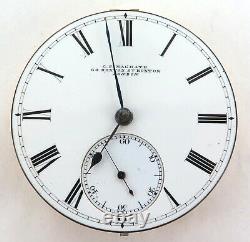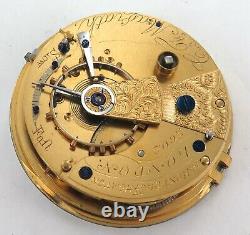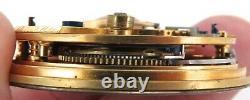
- Pocket Watch Movement
- Brand
- Agassiz (60)
- Antique (53)
- E. Howard Watch Co (38)
- Elgin (216)
- Hamilton (240)
- Hampden (52)
- Illinois (147)
- Iwc (123)
- Jaeger-lecoultre (32)
- Jules Jurgensen (38)
- Longines (146)
- Omega (108)
- Patek Philippe (167)
- Rockford (31)
- Rolex (60)
- Tiffany & Co. (44)
- Ulysse Nardin (48)
- Vacheron Constantin (112)
- Waltham (301)
- Zenith (40)
- ... (3506)
- Case Finish
- Case Material
- Department
- Movement Type
- Type
- Case (3)
- Cases (2)
- Chronograph Movement (5)
- Dial (2)
- Hand-winding (11)
- Montre Bracelet (2)
- Montre à Gousset (4)
- Movement (1439)
- Movement Part (20)
- Movment (2)
- Pocket Watch (813)
- Pocket Watches (3)
- Repeater (3)
- Repeater Case (4)
- Repeater Movement (3)
- Stopwatch (3)
- Watch (2)
- Wrist Watch (3)
- Wristwatch (173)
- Wristwatch Movement (2)
- ... (3063)
1800s C MAGRATH, LONDON DIAMOND END STONE LEVER FUSEE POCKET WATCH MOVEMENT








1800s C MAGRATH, LONDON DIAMOND END STONE LEVER FUSEE POCKET WATCH MOVEMENT. Unreliable, works then stops, ticking slower than it should, balance & wheel are good. It will need at least a service. Dial plate is 42.8mm in diameter, rear base plate 37.4mm. This is the buyers / importers responsibility. We are constantly adding to our ever increasing range and have a large assortment of American Railroad Grade Pocket Watches. Were amongst the highest grade watches made, having been made for the railways makes them a great choice to use every day, mainly for their durability over time. Their lower production quantities and of course their high grade movements make them also a great gift or investment.
A typical railroad's requirements for a pocket watch in the early 20th century might include. Only American-made watches may be used (depending on availability of spare parts).
Only open-faced dials, with the stem at 12 o. Minimum of 17 functional jewels in the movement. Size 16 or 18 only. Maximum variation of 30 seconds (approximately 4 seconds daily) per weekly check.
Watch adjusted to at least five positions: Face up and face down (the positions a watch might commonly take when laid on a flat surface); then crown up, crown pointing left, and crown pointing right (the positions a watch might commonly take in a pocket). Occasionally a sixth position, crown pointing down, would be included.
Adjusted for severe temperature variance and isochronism (variance in spring tension). Indication of time with bold legible Arabic numerals, outer minute division, second dial, heavy hands. Lever used to set the time (no risk of inadvertently setting the watch to an erroneous time, when winding the watch with the stem). Anti-magnetic protection (after the advent of diesel-electric locomotives). The minimum requirements were raised several times as watch-making technology progressed, and the watch companies produced newer, even more reliable models.
By WW2, many railroads required watches that were of a much higher grade (as many as 23 jewels, for example) than those made to comply with the original 1891 standard. _gsrx_vers_854 GS 7.0.18 (854). The item "1800s C MAGRATH, LONDON DIAMOND END STONE LEVER FUSEE POCKET WATCH MOVEMENT" is in sale since Thursday, March 19, 2020. This item is in the category "Jewellery & Watches\Watches, Parts & Accessories\Watches\Pocket Watches". The seller is "hnco" and is located in Woolloongabba, Brisbane.
This item can be shipped worldwide.
- Features: 12-Hour Dial
- Dial Colour: White
- MPN: Does Not Apply
- Department: Men
- Dial Style: Roman Numerals
- Year Manufactured: 1800s
- Escapement Type: Lever
- Brand: C Magrath
- Style: Dress/Formal
- Movement: Mechanical (Key-winding)
- Type: Pocket Watch Movement

